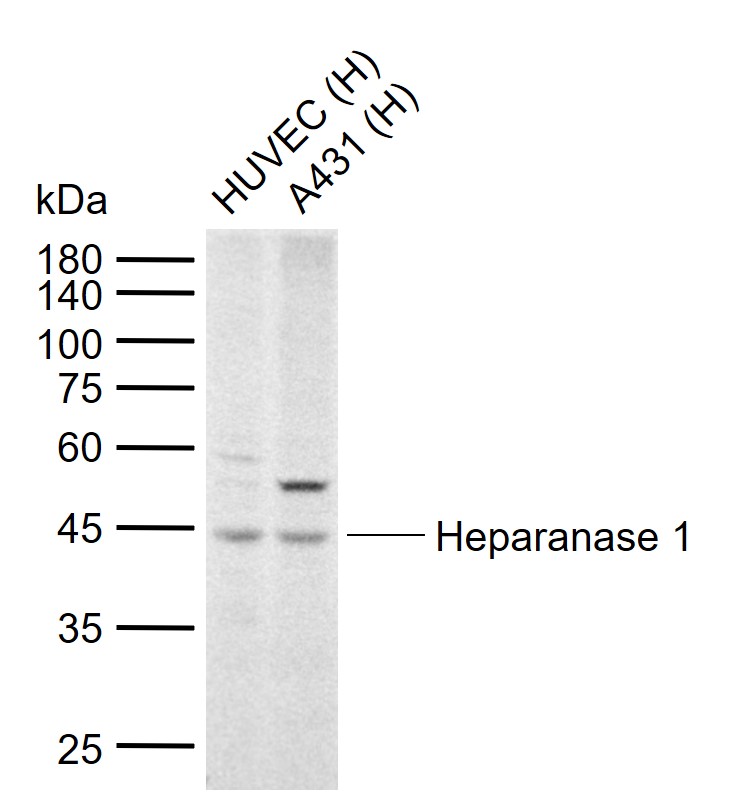
Anti-Heparanase 1 antibody
Heparanase 50 kDa subunit; heparanase; heparanase1; heparanase-1; heparanase 1; Endo glucoronidase; Endo glucoronidase; Endo-glucoronidase; HPSE_HUMAN; Heparanase1; Heparanase 1; HEP; Hpa 1; HPA; Hpa1; HPR 1; HPR1; HPSE 1; HPSE; HPSE1; HSE 1; HSE1.
View History [Clear]
Details
Product Name Heparanase 1 Chinese Name 乙酰肝素酶抗体 Alias Heparanase 50 kDa subunit; heparanase; heparanase1; heparanase-1; heparanase 1; Endo glucoronidase; Endo glucoronidase; Endo-glucoronidase; HPSE_HUMAN; Heparanase1; Heparanase 1; HEP; Hpa 1; HPA; Hpa1; HPR 1; HPR1; HPSE 1; HPSE; HPSE1; HSE 1; HSE1. Immunogen Species Clonality Polyclonal React Species (predicted: Human, ) Applications
not yet tested in other applications.
optimal dilutions/concentrations should be determined by the end user.Theoretical molecular weight 43kDa Cellular localization The nucleus cytoplasmic The cell membrane Secretory protein Form Lyophilized or Liquid Concentration 1mg/ml immunogen KLH conjugated synthetic peptide derived from human Heparanase 50 kDa subunit: 421-520/543 Lsotype IgG Purification affinity purified by Protein A Buffer Solution 0.01M TBS(pH7.4) with 1% BSA, 0.03% Proclin300 and 50% Glycerol. Storage Shipped at 4℃. Store at -20 °C for one year. Avoid repeated freeze/thaw cycles. Attention This product as supplied is intended for research use only, not for use in human, therapeutic or diagnostic applications. PubMed PubMed Product Detail Heparanase is an endo-beta-D-glucuronidase, which degrades heparan sulfate side chains of heparan sulfate proteoglycans (HSPGs) in the extracellular matrix. Heparanase plays an important role in ECM degradation, facilitating the migration and extravasations of tumor cells and inflammatory leukocytes. Upon degradation, heparanase releases growth factors and cytokines that stimulate cell proliferation and chemotaxis. Heparanase is a heterodimer comprised of a 50 kDa subunit harboring the active site and an 8 kDa subunit. It is produced as a latent 65 kDa precursor and proteolytically processed to its active form. Heparanase is highly expressed in myeloid leukocytes (i.e. neutrophils) in platelets and in human placenta. Human heparanase was found to be upregulated in various types of primary tumors, correlating in some cases with increased tumor invasiveness and vascularity and with poor prospective survival.
Function:
Endoglycosidase that cleaves heparan sulfate proteoglycans (HSPGs) into heparan sulfate side chains and core proteoglycans. Participates in extracellular matrix (ECM) degradation and remodeling. Selectively cleaves the linkage between a glucuronic acid unit and an N-sulfo glucosamine unit carrying either a 3-O-sulfo or a 6-O-sulfo group. Can also cleave the linkage between a glucuronic acid unit and an N-sulfo glucosamine unit carrying a 2-O-sulfo group, but not linkages between a glucuronic acid unit and a 2-O-sulfated iduronic acid moiety. It is essentially inactive at neutral pH but becomes active under acidic conditions such as during tumor invasion and in inflammatory processes. Facilitates cell migration associated with metastasis, wound healing and inflammation. Enhances shedding of syndecans, and increases endothelial invasion and angiogenesis in myelomas. Acts as procoagulant by increasing the generation of activation factor X in the presence of tissue factor and activation factor VII. Increases cell adhesion to the extacellular matrix (ECM), independent of its enzymatic activity. Induces AKT1/PKB phosphorylation via lipid rafts increasing cell mobility and invasion. Heparin increases this AKT1/PKB activation. Regulates osteogenesis. Enhances angiogenesis through up-regulation of SRC-mediated activation of VEGF. Implicated in hair follicle inner root sheath differentiation and hair homeostasis.
Subunit:
Heterodimer; heterodimer formation between the 8 kDa and the 50 kDa subunits is required for enzyme activity. Interacts with TF; the interaction, inhibited by heparin, enhances the generation of activated factor X and activates coagulation. Interacts with HRG; the interaction is enhanced at acidic pH, partially inhibits binding of HPSE to cell surface receptors and modulates its enzymatic activity. Interacts with SDC1; the interaction enhances the shedding of SDC1.
Subcellular Location:
Lysosome membrane; Peripheral membrane protein. Secreted. Nucleus. Note=Proheparanase is secreted via vesicles of the Golgi. Interacts with cell membrane heparan sulfate proteoglycans (HSPGs). Endocytosed and accumulates in endosomes. Transferred to lysosomes where it is proteolytically cleaved to produce the active enzyme. Under certain stimuli, transferred to the cell surface. Associates with lipid rafts. Colocalizes with SDC1 in endosomal/lysosomal vesicles. Accumulates in perinuclear lysosomal vesicles. Heparin retains proheparanase in the extracellular medium.
Tissue Specificity:
Highly expressed in placenta and spleen and weakly expressed in lymph node, thymus, peripheral blood leukocytes, bone marrow, endothelial cells, fetal liver and tumor tissues. Also expressed in hair follicles, specifically in both Henle's and Huxley's layers of inner the root sheath (IRS) at anagen phase.
Post-translational modifications:
Proteolytically processed. The cleavage of the 65 kDa form leads to the generation of a linker peptide, and 8 kDa and 50 kDa products. The active form, the 8/50 kDa heterodimer, is resistant to degradation. Complete removal of the linker peptide appears to be a prerequisite to the complete activation of the enzyme. N-glycosylated. Glycosylation of the 50 kDa subunit appears to be essential for its solubility.
Similarity:
Belongs to the glycosyl hydrolase 79 family.
SWISS:
Q9Y251
Gene ID:
10855
Database links:Entrez Gene: 10855 Human
Entrez Gene: 15442 Mouse
Omim: 604724 Human
SwissProt: Q9Y251 Human
SwissProt: Q6YGZ1 Mouse
SwissProt: Q8K3K3 Mouse
Unigene: 44227 Human
Unigene: 265786 Mouse
Unigene: 6392 Rat
乙酰肝素酶(heparanase)在血管形成、炎性反应、组织生长发育及Tumour转移的过程中起着重要作用。在正常情况下,乙酰肝素酶的分泌和活性必须受到严格的调控,以免其表达对Extracellular matrix错误切割造成组织损伤而发生各种病理改变。Product Picture
References (0)
No References
Bought notes(bought amounts latest0)
No one bought this product
User Comment(Total0User Comment Num)
- No comment



 +86 571 56623320
+86 571 56623320
 +86 18668110335
+86 18668110335

